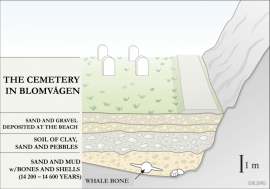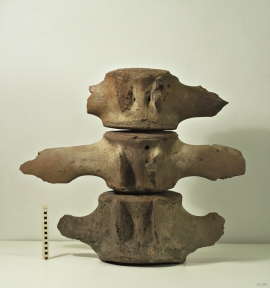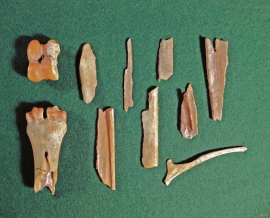Published: 05.08.2015 | Author: Jan Mangerud
Blomvågen 1851. Oil painting by Hans Leganger Reusch, father of the famous geologist, Hans Reusch.
WHALE BONE DISCOVERY
"One of the big scientific sensations", was the title in the Bergens Times newspaper on the 22nd of November, 1941. It was the geologist Isal Undås who had been interviewed by the newspaper. He thought that he had discovered a 120 000 year old whale bone, remains of life from before the last Ice Age.
The bone discovery was made by the workers who dug the drainage ditches for the new cemetery at the church in Blomvågen. Isak Undås stated that the bones lay under a layer of clay, sand and stone and he interpreted this as a moraine deposit from the bottom of a continental glacier. On the basis of the prevailing knowledge of ice age history at that time the geologist thought the whale must have lived before the last ice age. However, the deposits were not that old. In the 1960s, after the C-14 dating method was developed, the bones were dated to be from between 12,200 and 12,600 C-14 years old. This corresponds to roughly 14,200 and 14,600 years before present. The interpretation then was that there was a short, ice-free period near the end of the last ice age and the glacier grew about 14,000 years ago so that it covered Blomvåg and deposited the moraine over the layer containing the bones. But in 2016 a new scientific article was published on the Blomvåg find that showed that the latter was incorrect. Many newer dates indicate that the bone-containing layer was deposited over a longer time interval, from 14,800 to 13,200 years before present. Meanwhile, datings from other places showed that Blomøy was free of ice 14,800 years ago. The soil layer of clay, sand and stone is therefore not a moraine deposited by a glacier, but is now thought to have been formed when a mountain of ice and sea ice pressed toward land.
Nonetheless, the abundance of bones in the Blomvåg discovery makes it unique in Norway. During the period from 14,800 to 13,200 years ago there was vibrant life at Blomvågen, and surely also along the rest of the west coast. The giant bones of the Greenland whales were the most curious aspect of the Blomvåg find. This large baleen whale lives today in the waters of Greenland and Svalbard. The whale bones and other types of shells suggest that the climate of Blomvågen during the ice-free period was about the same as along the coast of Finnmark today. The fauna was dominated by shells, fish and birds. The Great Auk had come to Norway, a bird that couldn't fly, similar to the penguins in Antarctica. That is why it went extinct in the middle of the 1800s. Further in from the coast there was grazing land for reindeer. It is natural to suppose that humans followed the trail of the reindeer from Europe, but evidence of this was not found in Blomvågen. The bone-rich layer was deposited in shallow water in the ocean. The sea level at Blomvåg 14,000 years ago was roughly 25 metres higher than today, but it was only 17 metres higher 13,200 years ago, which is about the same level as the cemetary.12,000 years ago sea levels rose again by nearly 30 metres.
Schematic diagram of the sequence of layers in the burial place at Blomvågen. (Jan Mangerud/Eva Bjørseth)
- Undås, I. 1942. Fossilfunnet i Blomvåg. Naturen: 97–107.








